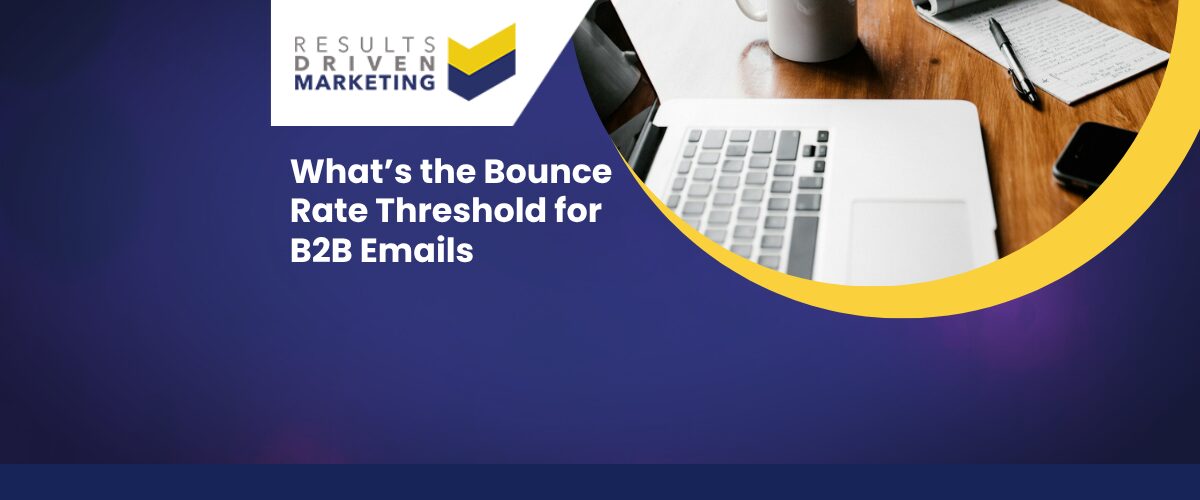What’s the bounce rate threshold for B2B emails? If you’re a UK SME using purchased data for outreach, it’s a metric you can’t afford to ignore. Bounce rates impact deliverability, sender reputation, and campaign ROI—and when they spike, your entire outreach can suffer.
In this guide, we’ll cover what bounce rates mean (hard vs soft bounces), what safe thresholds look like, and how to keep your lists clean. By the end, you’ll know exactly how to monitor, manage, and improve bounce performance for better email deliverability and higher returns.
Table of contents:
Why Bounce Rates Matter for UK SMEs
For UK SMEs using email campaigns to generate leads, bounce rates are more than a number—they’re a health check on your outreach strategy:
-
Sender reputation: ISPs use bounce history to judge trust—high rates reduce inbox placement chances.
-
Blocked or blacklisted domains: Consistent bounce spikes can land you on blocklists.
-
Wasted effort and budget: Bounced emails cost time, list credits, and lead to skewed campaign performance data.
-
Poor engagement signals: If your emails don’t reach contacts, opens, clicks, and replies drop immediately.
Every bounce is real money and trust lost—so managing bounce rates should be a central part of your strategy.
Understanding Hard vs. Soft Bounces
Before managing bounce thresholds, it’s vital to understand the two types of bounces—and why they demand different responses.
Hard Bounces
Hard bounces are permanent delivery failures, caused by:
-
Invalid or closed email addresses
-
Misspelt domains or non-existent accounts
-
Business closure or inaccurate contact data
Why it matters: Hard bounces immediately harm sender reputation. Remove them ASAP.
Soft Bounces
Soft bounces are temporary issues, such as:
-
Recipient inbox is full
-
Server downtime or temporary blocks
-
Email flagged or size issues
How to handle them: Re-send once or twice; if they keep bouncing, treat as a hard bounce and remove.
Recommended Bounce Rate Thresholds
So, what’s the bounce rate threshold for B2B emails? Here’s what industry best practices suggest:
-
Total bounce rate (hard + soft): Keep under 3% per campaign
-
Hard bounce rate: Ideally below 2%
-
Soft bounce rate: Acceptable up to ~1–2%, but monitor closely
Even a single campaign with a >5% bounce rate is a red flag. This indicates poor data or delivery issues and can signal email platforms to block future sends.
Proactive Strategies to Control Bounce Rates
Bounces don’t fix themselves—but with a few smart habits, you can prevent spikes and protect deliverability:
Clean Data Lists Before Sending
-
Choose UK-based providers that refresh data regularly
-
Prioritise recent contacts with confirmed activity
-
Avoid stale or third-party data sources
Ongoing Maintenance
-
Remove hard bounced addresses from your list immediately
-
Suppress repeat soft bounces after 2–3 attempts
-
Review bounce trends and pause failing segments
Monitor and Respond
-
Set alerts for campaigns exceeding ~3% bounce rate
-
Pause suspect campaigns and review list logic or timing
-
Adapt future sending strategies based on data feedback
Impact of Bounce Rate on Deliverability and ROI
Bounce rate isn’t just a minor metric—it changes how your campaigns perform:
-
Inbox placement continuity: High bounce rates reduce visibility for future sends
-
Accurate campaign analytics: High bounces distort open/click rate data
-
Cost efficiency: You’re paying for contacts that don’t exist or reach a valid inbox
-
Brand perception: Frequent bounces suggest poor professionalism and planning
Controlling bounce rates protects your deliverability and maximises the value of every outreach effort.
Why Choose Results Driven Marketing
At Results Driven Marketing, we support UK SMEs with high-quality data and bounce-safe outreach:
-
Clean, campaign-ready data: Each list is vetted to minimise delivery risk
-
UK segmentation expertise: Filter by job title, sector, region, turnover, and more
-
Human, practical advice: Guidance on monitoring metrics and maintaining deliverability
-
Compliance aligned with GDPR: List building meets UK regulatory standards
-
Built for ROI: Targeted, accurate data to drive campaigns that convert
Need smarter bounce control or campaign-ready segmentation? Visit our email lists page or contact us to get started.
Final Thoughts: Stay Below the Threshold, Stay in the Inbox
What’s the bounce rate threshold for B2B emails? For UK SMEs, aim for under 3% total bounce rate and under 2% hard bounces. This keeps your domain safe, deliverability high, and campaigns effective.
Keep your lists clean, monitor your performance, and adjust proactively. Bounce rate management isn’t optional—it’s critical for consistent results.
Whether you’re sending hundreds or thousands, we can help you stay compliant, clean, and thoughtfully focused. Ready to lower your bounce rate and improve ROI? Contact us or explore our targeted email lists built for high deliverability and real campaign success.
Results Driven Marketing
IIB Trading Ltd, trading as Results Driven Marketing
📍 Cobalt Business Exchange, Newcastle
📞 0191 406 6399
🌐 rdmarketing.co.uk
Helping UK SMEs go from bad data to more customers and profits.





